
Prodeinotherium is an extinct representative of the family Deinotheriidae that lived in Africa, Europe, and Asia in the early and middle Miocene. Prodeinotherium, meaning "before terrible beast", was first named in 1930, but soon after, the only species in it, P. hungaricum, was reassigned to Deinotherium. During the 1970s, however, the two genera were once again separated, with Prodeinotherium diagnosed to include Deinotherium bavaricum, Deinotherium hobleyi, and Deinotherium pentapotamiae, which were separated based on geographic location. The three species are from Europe, Africa, and Asia, respectively. However, because of usage of few characters to separate them, only one species, P. bavaricum, or many more species, including P. cuvieri, P. orlovii, and P. sinense may be possible.

Janjucetus is an extinct genus of cetacean, and a basal baleen whale (Mysticeti), from the Late Oligocene around 25 million years ago (mya) off south-east Australia, containing one species J. hunderi. Unlike modern mysticetes, it possessed large teeth for gripping and shredding prey, and lacked baleen, and so was likely to have been a predator that captured large single prey animals rather than filter feeding. However, its teeth may have interlocked, much like those of the modern-day filter-feeding crabeater seal, which would have allowed some filter-feeding behaviour. Its hunting behaviour was probably similar to the modern-day leopard seal, probably eating large fish. Like baleen whales, Janjucetus could not echolocate; however, it did have unusually large eyes, and so probably had an acute sense of vision. The only specimen was found on the Jan Juc beach, where the remains of the extinct whales Mammalodon, Prosqualodon and Waipatia have also been discovered.
Mammalodon is an extinct genus of archaic baleen whale belonging to the family Mammalodontidae.

Mammalodontidae is a family of extinct whales known from the Oligocene of Australia and New Zealand.
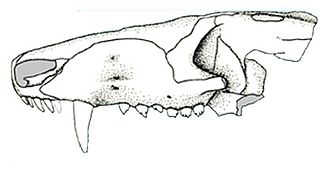
Prozostrodon is an extinct genus of probainognathian cynodonts that was closely related to mammals. The remains were found in Brazil and are dated to the Carnian age of the Late Triassic. The holotype has an estimated skull length of 6.7 centimetres (2.6 in), indicating that the whole animal may have been the size of a cat. The teeth were typical of advanced cynodonts, and the animal was probably a carnivore hunting reptiles and other small prey.

Aetiocetus is a genus of extinct basal mysticete, or baleen whale that lived 33.9 to 23.03 million years ago, in the Oligocene in the North Pacific ocean, around Japan, Mexico, and Oregon, U.S. It was first described by Douglas Emlong in 1966 and currently contains known four species, A. cotylalveus, A. polydentatus, A. tomitai, and A. weltoni. These whales are remarkable for their retention of teeth and presence of nutrient foramina, indicating that they possessed baleen. Thus, Aetiocetus represents the transition from teeth to baleen in Oligocene mysticetes. Baleen is a highly derived character, or synapomorphy, of mysticetes, and is a keratinous structure that grows from the palate, or roof of the mouth, of the whale. The presence of baleen is inferred from the fossil record in the skull of Aetiocetus. Aetiocetus is known from both sides of the Pacific Ocean: it was first documented in Oregon, United States, but it is also known from Japan and Mexico. The genus is currently constrained to the Northern hemisphere and has little value in biostratigraphic studies of the Oligocene due to its limited occurrences across the Pacific.

Aelurosaurus is a small, carnivorous, extinct genus of gorgonopsian therapsids from the Late Permian of South Africa. It was discovered in the Karoo Basin of South Africa, and first named by Richard Owen in 1881. It was named so because it appeared to be an ancestor for cat-like marsupials, but not yet a mammal itself. It contains five species, A. felinus, A. whaitsi, A. polyodon, A. wilmanae, and A.? watermeyeri. A. felinus, the type species, is generally well described with established features, while the other four species are not due to their poorly preserved holotypes.

Astorgosuchus is an extinct monospecific genus of crocodilian, closely related to true crocodiles, that lived in Pakistan during the late Oligocene period. This crocodile may have reached lengths of up to 7–8 m (23–26 ft) and is known to have preyed on many of the large mammals found in its environment. Bite marks of a large crocodile have been found on the bones of juvenile Paraceratherium, however if these were left by Astorgosuchus cannot be said with certainty. The genus contains a single species, Astorgosuchus bugtiensis, which was originally named as a species of Crocodylus in 1908 and was moved to its own genus in 2019.

Waharoa is a genus of eomysticetid baleen whale from the Late Oligocene (Chattian) of New Zealand. It was identified with the discovery of Waharoa ruwhenua by Boessenecker and Fordyce (2015), which added a new genus and species to a monophyletic family Eomysticetidae.
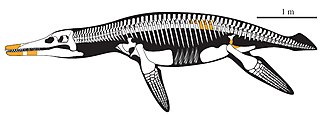
Makhaira rossica is an extinct genus and species of a marine reptile belonging to the family Pliosauridae. It lived during the early Cretaceous period, and its fossils have been found in Russia.

Coronodon is a genus of toothed (transitional) baleen whales from the Early Oligocene Ashley and Chandler Bridge formations of South Carolina. The genus contains three species: the type species C. havensteini, and additional species C. newtonorum and C. planifrons.

Arktocara is an extinct genus of river dolphin from the Oligocene epoch of Alaska, containing one species, A. yakataga. Having been discovered in 25-million-year-old strata near the 60th parallel north, it is perhaps the oldest-known crown toothed whale and the northmost river dolphin discovered. It was a member of the now-extinct family Allodelphinidae, along with the genera Allodelphis, Goedertius, Ninjadelphis, and Zarhinocetus. It measured approximately 2.26 or 2.28 meters, comparable to its closest living relative, the South Asian river dolphin, which measures 2.4 meters (7.9 ft). However, the animal probably had an elongated beak and neck, so it may have been longer. The animal is known only from a partially preserved skull. Its ecology may have been similar to the modern-day Dall's porpoise, and it may have competed with contemporaneous delphinoids. Its remains were found in the Poul Creek Formation, which has also yielded several mollusk species.
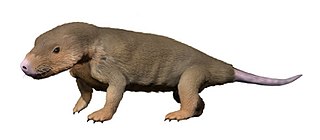
Abdalodon is an extinct genus of late Permian cynodonts, known by its only species A. diastematicus.Abdalodon together with the genus Charassognathus, form the clade Charassognathidae. This clade represents the earliest known cynodonts, and is the first known radiation of Permian cynodonts.
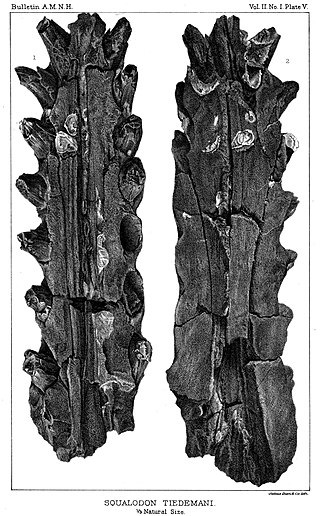
Ankylorhiza is an extinct genus of toothed whale that lived in what is now the United States during the Oligocene epoch, between 29 and 23.5 million years ago. The type and only known species is A. tiedemani, though two fossil skeletons may represent an additional, second species within the genus. Ankylorhiza was about 4.8 meters (16 ft) long, with a long, robust skull bearing conical teeth that were angled forwards at the tip of the snout.

Ictidosaurus was a therapsid genus found in the Abrahamskraal Formation of South Africa, which lived during the middle Permian period. Fossils of the type species were found in the Tapinocephalus, and the base of the Eodicynodon assembly zones, of the Karoo Basin. Older classifications of the species, along with many other specimens found in the Iziko South African Museum archives, were originally classified within therocephalian family names, in this case the Ictidosauridae, which has been reclassified as belonging to the Scylacosauridae. The type species is I. angusticeps.

Kyhytysuka is an extinct genus of ophthalmosaurian ichthyosaur from Early Cretaceous Colombia. The animal was previously assigned to the genus Platypterygius, but given its own genus in 2021. Kyhytysuka was a mid-sized ophthalmosaurian with heterodont dentition and several adaptations suggesting that it was a macropredatory vertebrate hunter living in shallow waters. It contains a single species, Kyhytysuka sachicarum.
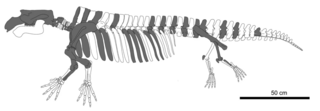
Sobrarbesiren is a genus of extinct sirenian that lived in the Eocene, about 47 million years ago. The type and only species is S. cardieli, known from a multitude of specimens from the Spanish Pyrenees. Sobrarbesiren was a medium-sized animal, 2.7 m long and still retaining both pairs of limbs. Although initially thought to be amphibious, later studies instead suggest that they would have been fully aquatic and been selective sea grass browsers. Unlike modern dugongs and manatees, they likely lacked a tail fluke, although it would have appeared horizontally flattened.
Ammitocyon is a genus of large sized carnivoran mammals, belonging to the Amphicyonidae, that lived during the Late Miocene in what is now Spain. It is notable for its extreme adaptations towards hypercarnivory, its extremely robust skeleton, and was one of the last surviving members of its family.
Eoarctos is an extinct genus of arctoid carnivorans, known from the latest Eocene to early Oligocene of North Dakota and Nebraska. It is known from several remains, the most notable of which is the almost perfectly preserved skeleton of a large male. It was comparable in build and size to a fisher or small raccoon, with an estimated body mass of 4.3 kg, and possessed a variety of features that indicate a mix of terrestrial and scansorial locomotion. Its most notable feature is its unique dentition, with its massive premolars and hypocarnivorous molars, as well as its robust mandible, indicating that it consumed hard-shelled prey, possibly making it the oldest molluscivorous carnivoran known.

Nihoroa is an extinct genus of waipatiid odontocete cetacean from the glauconitic Otekaike Limestone in North Otago; New Zealand. The type species is N. reimaea, known from only the holotype which comprises various skull elements.
















